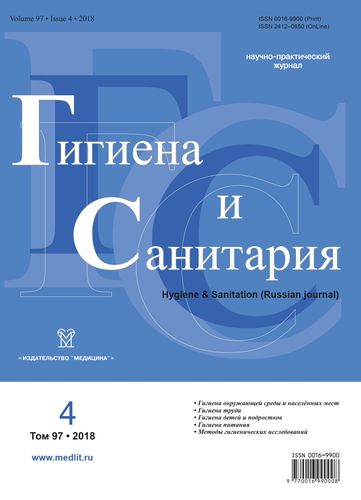Results of the complex risk factor assessment for the coronary heart disease in working population
- Autores: Maksimov S.A.1, Tabakaev M.V.1, Chigisova A.N.1, Artamonova G.V.1
-
Afiliações:
- Research Institute of complex problems of cardiovascular disease
- Edição: Volume 97, Nº 4 (2018)
- Páginas: 310-314
- Seção: OCCUPATIONAL HYGIENE
- ##submission.datePublished##: 20.10.2020
- URL: https://medjrf.com/0016-9900/article/view/640312
- DOI: https://doi.org/10.47470/0016-9900-2018-97-4-310-314
- ID: 640312
Citar
Texto integral
Resumo
Material and methods. Three groups of men working in Kemerovo region were formed: 694 “white-collar”, 1674 “blue-collar” and 1612 “coal-miners”. To form the comparison group we used data from the Russian research ESSE-RF in the Kemerovo region (700 men). The following cardiovascular risk factors were assessed: hypercholesterolemia, hypertriglyceridemia, hyperglycemia, obesity, hypertension, smoking, and education level. The coronary heart disease (CHD) was diagnosed on the basis of ECG changes on the Minnesota code, Rose questionnaire, and myocardial infarction. According to the frequency of risk factors and their contribution to the probability of developing the coronary heart disease, there was calculated the total burden of CHD risk factors (Maksimov S.A. et al., 2015).
Results. The burden of CHD risk factors in the general population up to 51 years accounts for 308 conventional units. There is a variety of risk factors frequency in the working groups, both inside the groups and in comparison with the general population. Consequently, there are differences in values of CHD risk factors burdens. The “blue-collar” burdens of CHD risk factors corresponding to the general population (304 conventional units). In “white-collar” and “miners” this parameter is lower, respectively, 266 and 259 conventional units. After 50 years, the total burden of CHD risk factors in the population increased to 472 conventional units (1.5 times). Differences of this index in the working groups to the general population after 50 years also increased.
Conclusion. The working population is characterized by the low total burden of CHD risk factors compared with the general population. After 50 years, these differences increase, which indicates the deterioration of health with age, stimulates the individual to the termination of employment or the ongoing the work as the healthiest individuals. The lowest rates of CHD risk factors burden have been reported in “miners”, the average — in “white collar”, maximum — in “blue-collar”.
Palavras-chave
Sobre autores
Sergey Maksimov
Research Institute of complex problems of cardiovascular disease
Autor responsável pela correspondência
Email: m1979sa@yandex.ru
ORCID ID: 0000-0003-0545-2586
MD, Ph.D., associate professor, leading researcher of the Department Epidemiology of Cardiovascular Diseases Research Institute for Complex Issues of Cardiovascular Diseases, , Kemerovo, 650002, Russian Federation.
e-mail: m1979sa@yandex.ru
RússiaM. Tabakaev
Research Institute of complex problems of cardiovascular disease
Email: noemail@neicon.ru
ORCID ID: 0000-0002-1966-3985
Rússia
A. Chigisova
Research Institute of complex problems of cardiovascular disease
Email: noemail@neicon.ru
ORCID ID: 0000-0001-8147-925X
Rússia
G. Artamonova
Research Institute of complex problems of cardiovascular disease
Email: noemail@neicon.ru
ORCID ID: 0000-0003-2279-3307
Rússia
Bibliografia
- Izmerov N.F., Tikhonova G.I., Gorchakova T.Yu. Mortality of working age population in Russia and indusrial countries in Europe: trends of the last two decades. Vestnik Rossiyskoy akademii meditsinskikh nauk. 2014; 69(7-8): 121-6. (in Russian)
- Muromtseva G.A., Kontsevaya A.V., Konstantinov V.V., Artamonova G.V., Gatagonova T.M., Duplyakov D.V., Efanov A.Yu., Zhernakova Yu.V., Il’in V.A., Konradi A.O., Libis R.A., Minakov A.V., Nedogoda S.V., Oshchepkova E.V., Romanchuk S.V., Rotar’ O.P., Trubacheva I.A., Deev A.D., Shal’nova S.A., Chazova I.E. The prevalence of non-infectious diseases risk factors in Russian population in 2012-2013 years. The results of ECVD-RF. Kardiovaskulyarnaya terapiya i profilaktika. 2014; 13(6): 4-11. (in Russian)
- Maksimov S.A., Tabakaev M.V., Artamonova G.V. Integral assessment of coronary heart disease risk in the epidemiological studies (ESSE-RF in the Kemerovo Region). Communication II: Socioeconomic determinants. Profilakticheskaya meditsina. 2016; 19(1): 24-9. (in Russian)
- Maksimov S.A., Skripchenko A.E., Artamonova G.V. Integral assessment of work-related arterial hypertension risk factors. Rossiyskiy kardiologicheskiy zhurnal. 2015; 4(120): 38-42. (in Russian)
- Kontsevaya A.V., Shal’nova S.A., Balanova Yu.A., Deev A.D., Artamonova G.V., Gatagonova T.M., Grinshteyn Yu.I., Duplyakov D.V., Efanov A.Yu., Zhernakova Yu.V., Il’in V.A., Konradi A.O., Libis R.A., Minakov A.V., Nevzorova V.A., Nedogoda S.V., Oganov R.G., Romanchuk S.V., Rotar’ O.P., Trubacheva I.A. Social and economic gradients of behavioral risk factors in Russian population (by the ESSE-RF study). Kardiovaskulyarnaya terapiya i profilaktika. 2015; 14(4): 59-67. (in Russian)
- Noordt M., Ijzelenberg H., Droomers M., Proper K. Health effects of employment: a systematic review of prospective studies. Occup. Environ. Med. 2014; 71(10): 730-6.
- Maksimov S.A., Artamonova G.V. Importance of occupational selection in prevalence of hypertension: effects of healthy and unhealthy worker. Vestnik Rossiyskoy akademii meditsinskikh nauk. 2013; (9): 37-41. (in Russian)
- Maksimov S.A., Indukaeva E.V., Mulerova T.A., Danil’chenko Ya.V., Tabakaev M.V., Artamonova G.V. Relationship between cardiovascular health and employment of senior people (the ESSE-RF in the Kemerovo region). Sotsial’nye aspekty zdorov’ya naseleniya. 2016; 47(1): 6. (in Russian)
- Skrobonja A., Kontosic I. Arterial hypertension in correlation with age and body mass index in some occupational groups in the harbour of Rijeka, Croatia. Ind. Health. 1998; 36(4): 312-7.
- Maksimov S.A. The burden and tension of labor in miners and the age structure of workers. Gigiena i sanitariya. 2010; (6): 40-3. (in Russian)
- Rice N.E., Lang I.A., Henley W., Melzer D. Common health predictors of early retirement: finding from the English Longitudinal Study of Ageing. Age Ageing. 2011; 40(1): 54-61.
- Fukuda Y., Hiyoshi A. Associations of household expenditure and marital status with cardiovascular risk factors in Japanese adults: analysis of nationally representative surveys. J. Epidemiol. 2013; 23(1): 21-7.
- Pickering T. Cardiovascular pathways: socioeconomic status and stress effects on hypertension and cardiovascular function. Ann. N. Y. Acad. Sci. 1999; 896: 262-77.
Arquivos suplementares








